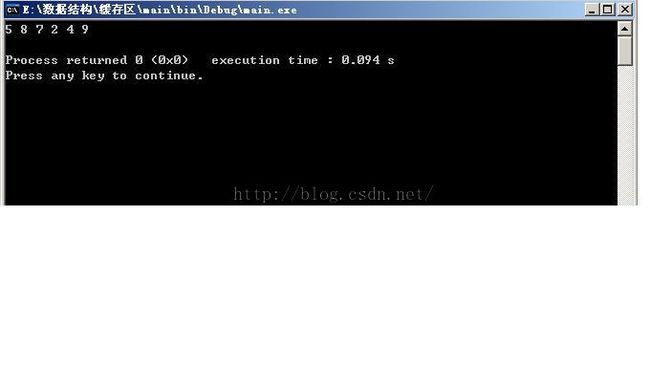第3周 项目2 - 建设“顺序表”算法库
问题描述:
采用程序的多文件组织形式,在项目1的基础上,建立头文件lish.h(包含定义顺序表结构的代码、宏定义、要实现算法的函数的声明)和源文件function.cpp(包含实现各种算法的函数的定义)
main.cpp 中的代码
#include "list.h"
int main()
{
SqList *sq;
ElemType x[6]={5,8,7,2,4,9};
CreateList(sq,x,6);
DispList(sq);
return 0;
}
function.cpp中的代码
#include "list.h"
//用数组创建线性表
void CreateList(SqList *&L,ElemType a[],int n)
{
int i;
L=(SqList *)malloc(sizeof(SqList));
for(i=0;i<n;i++)
L->date[i]=a[i];
L->length=n;
}
//初始化线性表InitList(L)
void InitList(SqList *&L) //引用型指针
{
L=(SqList *)malloc(sizeof(SqList));
//分配存放线性表的空间
L->length=0;
}
//销毁线性表DestroyList(L)
void DestroyList(SqList *&L)
{
free(L);
}
//判定是否为空表ListEmpty(L)
bool ListEmpty(SqList *L)
{
return(L->length==0);
}
//求线性表的长度ListLength(L)
int ListLength(SqList *L)
{
return(L->length);
}
//输出线性表DispList(L)
void DispList(SqList *L)
{
int i;
if (ListEmpty(L)) return;
for (i=0; i<L->length; i++)
cout<<L->date[i]<<' ';
cout<<endl;
}
//求某个数据元素值GetElem(L,i,e)
bool GetElem(SqList *L,int i,ElemType &e)
{
if(i<1||i>L->length) return false;
e=L->date[i-1];
return true;
}
//按元素值查找LocateElem(L,e)
int LocateElem(SqList *L,ElemType e)
{
int i=0;
while(i<L->length&&L->date[i]!=e)
i++;
if(i>=L->length)
return 0;
else
return i+1;
}
//插入数据元素ListInsert(L,i,e)
bool ListInsert(SqList *&L,int i,ElemType e)
{
int j;
if (i<1 || i>L->length+1)
return false; //参数错误时返回false
i--; //将顺序表逻辑序号转化为物理序号
for (j=L->length; j>i; j--) //将data[i..n]元素后移一个位置
L->date[j]=L->date[j-1];
L->date[i]=e; //插入元素e
L->length++; //顺序表长度增1
return true; //成功插入返回true
}
bool ListDelete(SqList *&L,int i,ElemType &e)
{
int j;
if(i<1||i>L->length) //参数错误时返回false
return false;
i--;
e=L->date[i];
for(j=i;j<L->length-1;j++) //将data[i..n-1]元素前移
L->date[j]=L->date[j+1];
L->length--; //顺序表长度减1
return true; //成功删除返回true
}
list.h中的代码
#ifndef LIST_H_INCLUDED
#define LIST_H_INCLUDED
#include <iostream>
using namespace std;
#include <malloc.h>
#define MaxSize 50
typedef int ElemType;
typedef struct
{
ElemType date[MaxSize];
int length;
}SqList;
void CreateList(SqList *&L, ElemType a[], int n);//用数组创建线性表
void InitList(SqList *&L);//初始化线性表InitList(L)
void DestroyList(SqList *&L);//销毁线性表DestroyList(L)
bool ListEmpty(SqList *L);//判定是否为空表ListEmpty(L)
int ListLength(SqList *L);//求线性表的长度ListLength(L)
void DispList(SqList *L);//输出线性表DispList(L)
bool GetElem(SqList *L,int i,ElemType &e);//求某个数据元素值GetElem(L,i,e)
int LocateElem(SqList *L, ElemType e);//按元素值查找LocateElem(L,e)
bool ListInsert(SqList *&L,int i,ElemType e);//插入数据元素ListInsert(L,i,e)
bool ListDelete(SqList *&L,int i,ElemType &e);//删除数据元素ListDelete(L,i,e)#endif // LIST_H_INCLUDED
#endif // LIST_H_INCLUDED
运行结果:
知识点总结:
逻辑序号和物理序号的转化关系,熟练指针和引用的运用,以及此程序中明白指针的引用的原理。善于将抽象问题结合到社会实际生活中。从而更加形象生动的加深自己对问题的理解。
学习心得:
在今后的学习中。可以建立自己的算法库,在做类似的项目时,可以直接调用自己储存的算法。这样以来可以大大提高效率。
